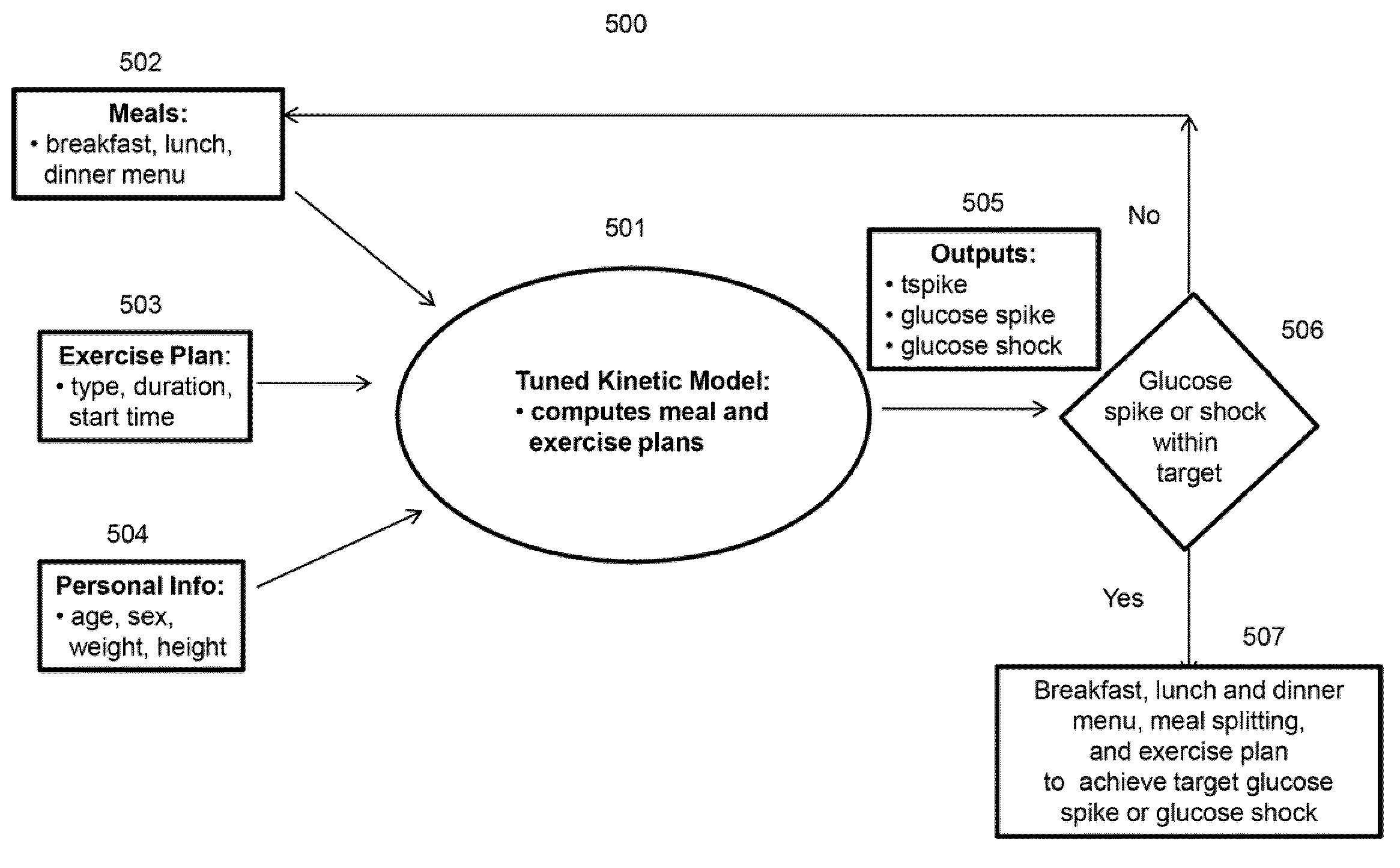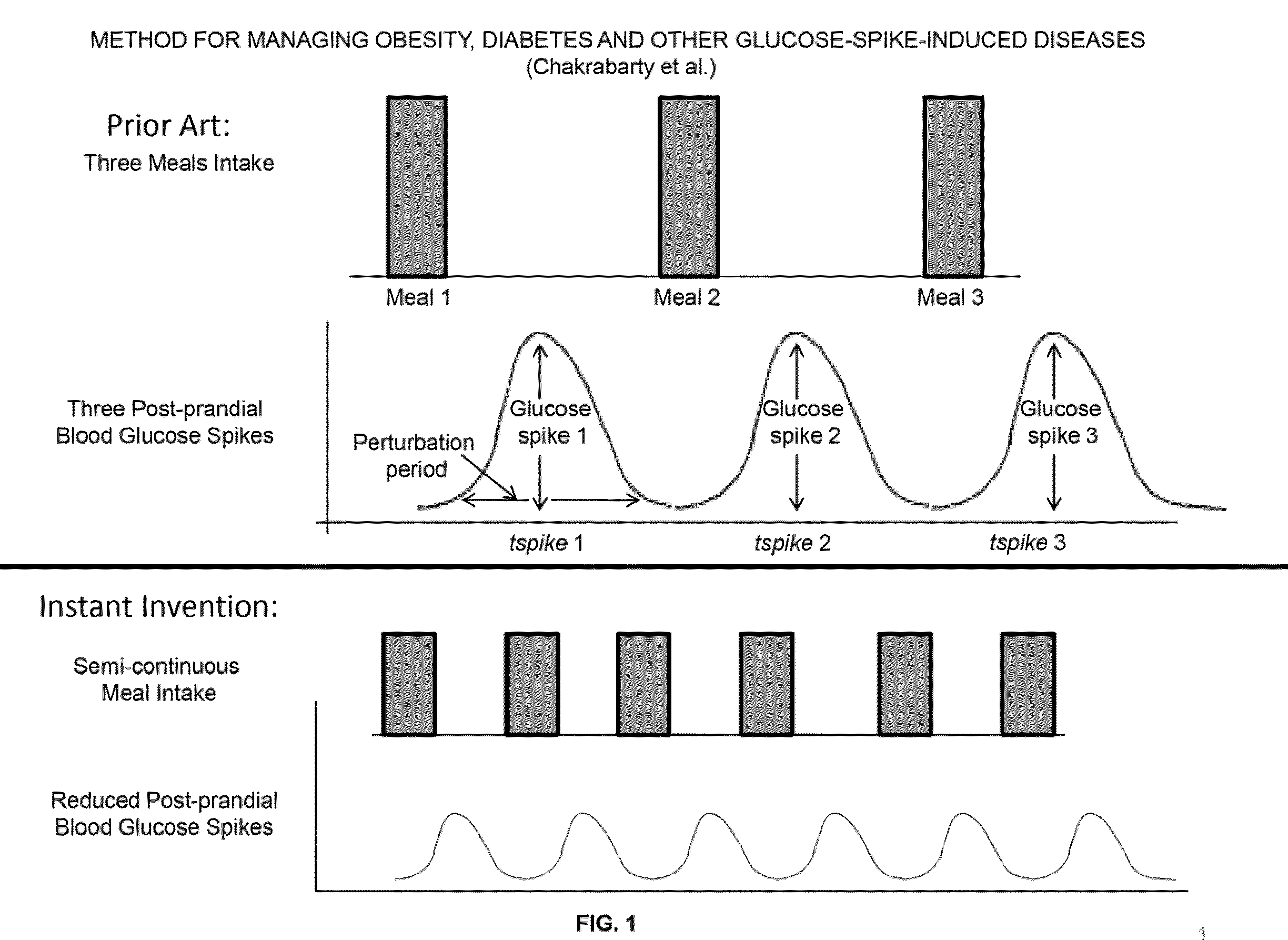Method for Managing Obesity, Diabetes and Other Glucose-Spike-Induced Diseases
a technology for diabetes and other glucose-induced diseases, applied in the field of managing obesity, abdominal fat, diabetes, other glucose-induced diseases, can solve the problems of obesity becoming a significant health risk, inefficient glucose uptake by the body cells, and elevated lipids in the blood, so as to manage those diseases more effectively, and reduce the risk of developing various glucose-induced diseases
- Summary
- Abstract
- Description
- Claims
- Application Information
AI Technical Summary
Benefits of technology
Problems solved by technology
Method used
Image
Examples
example 1
Reducing Abdominal Fat and Body Weight by Following the Method of this Invention
[0135]A runner carried abdominal fat that was conspicuous even after completing 13 consecutive marathons over 10 years. After reducing the post-prandial glucose spike and the glucose shock by following the meal splitting and the post-meal exercise plans recommended by the tuned person-specific blood glucose response model of the instant invention, he was able to get rid of the abdominal fat, while losing 6 kg of body weight from an initial weight of 70 kg in six weeks.
[0136]Both abdominal fat and body weight reductions were achieved without lowering total carbohydrates intake and without taking any medicine.
[0137]This example shows that the person-specific, quantitative method of this invention is superior to strenuous training required for completing multiple marathons in terms of losing abdominal fat and body weight.
example 2
Lowering Blood Glucose Level from Diabetic to Normal Range by Practicing this Invention (Comparative Example)
[0138]After completing 13 consecutive marathons over 10 years, the runner from Example 1, was diagnosed with Type 2 diabetes with a 12-hour fasting glucose level of 7.7 mmol / L and symptoms of shortness of breath, numbness in toes, fingers and around the skull. This diagnosis was unexpected in view of his healthy life style, diet and fitness level.
[0139]Within six weeks of following the method of this invention, the runner was able to lower his 12-hour fasting glucose level from the diabetic to a normal range. The first non-shaded column in FIG. 10 shows the 12-hour fasting glucose before using the method of this invention to be 7.7 mmol / L, which is in the diabetic range. The same figure also shows in darker shaded columns the 12-hour fasting glucose levels over six consecutive days after the runner had used the method of this invention. The glucose levels varied over a narrow...
example 3
Generating a Personal Blood Glucose Profile, According to this Invention
[0142]In generating a personal, meal-specific glucose profile for the runner from Examples 1 and 2, an experimental program was designed, and the experimental data collected and recorded in a spreadsheet embedded in a desktop computer with an XP Professional operating system and a Samsung monitor. The blood glucose level was monitored using an OneTouch UltraSmart monitor, OneTouch Ultra Test Strips and OneTouch UltraSoft lancets, manufactured by LifeScan Inc. Milpitas, Ca, USA. The monitor was checked for accuracy using the OneTouch Ultra control solution. The pre-breakfast glucose level and the glucose levels after breakfast were monitored at different times to identify the tspike and the Gmax. Movement of body parts was minimized during the test period so as not to introduce any confounding effect of physical activity on the results. The measurements were continued until the blood glucose level stabilized, app...
PUM
 Login to View More
Login to View More Abstract
Description
Claims
Application Information
 Login to View More
Login to View More - R&D
- Intellectual Property
- Life Sciences
- Materials
- Tech Scout
- Unparalleled Data Quality
- Higher Quality Content
- 60% Fewer Hallucinations
Browse by: Latest US Patents, China's latest patents, Technical Efficacy Thesaurus, Application Domain, Technology Topic, Popular Technical Reports.
© 2025 PatSnap. All rights reserved.Legal|Privacy policy|Modern Slavery Act Transparency Statement|Sitemap|About US| Contact US: help@patsnap.com



